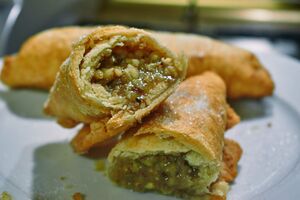Casadielles
Casadielles may be the single most loved pastry in all of Asturias. Similar to a turnover or a hand pie, they are filled with a heady mixture of crushed walnuts, sugar, and anise flavored liquor. Then they are cooked and and dusted with more sugar. They are immensely popular during the winter months, and make an appearance on the sweets tray of every güela (grandma) at Christmas. Additionally, they are very popular at espichas throughout the year.
Platos Tipicos de Asturias, the seminal regional cookbook first published in 1971, lists three separate recipes for Casadielles. Baked, fried, and a special recipe from the first town I lived in in Asturias – Pola de Lena. The fried kind are the most common from what I have seen. So that is the recipe I will share with you today. Indeed, the filling changes slightly from area to area in Asturias. Sometimes hazelnuts instead of walnuts, sometimes honey instead of sugar. And sometimes sherry or white wine instead of anís.
This particular recipe for casadielles is my own, based on the variations that I personally enjoy most.
They will keep for a day or two in a tightly sealed container, but are best a few moments after they come out of the fryer.
Ingredients
For the Dough
- 150 ml Neutral oil. Vegetable, canola, and corn oils all work well.
- 150 ml dry white wine. I really want to use cider in this recipe, but it doesn’t work as well. The alcohol content is not high enough.
- 1 egg yolk. Separate and reserve the white for later.
- 450 g All-purpose flour.
- 2 tbsp baking powder.
For the Filling
- 250 g peeled walnuts.
- 150 g granulated sugar.
- 6 tbsp whole milk.
- 4 tbsp anisette. If you can find a Spanish Anís, use that, if not, whatever the sweetest stickiest cheap one your liquor store has will be fine.
Instructions
For the Dough
- Mix together the wine, egg yolk, and oil with a pinch of salt.
- Whisk or sift together the flour and baking powder
- Add the liquid mix to the flour mix, and knead by hand until you get a smooth ball of dough. It should not stick to your hands.
- Set it aside to rest for at least an hour. I put mine in a gallon size freezer bag.
For the Filling
- Using a food processor, chop the walnuts very small. Not to dust, but close enough.
- To the walnuts, add the sugar, milk, and anisette. Stir and set aside to soak until the dough is done resting.
To Assemble & Fry
- Begin heating a couple of inches of oil in a deep frying pan. Cast iron is good for this as it maintains it’s temperature very well. Alternatively, use a deep fryer.
- To make a rectangle of dough:
- Form your dough into a ball.
- Cut an “X” into the top of the dough about 2/3 through the thickness of it.
- Now as you roll it out, it will be more of a rectangle.
- Cut the rolled out dough into rectangle. You can get at least 8 out of this recipe
- On each rectangle, put a spoonful of the filling, leaving a cm or two around the edge.
- Using a pastry brush, paint the edge with some of the egg white reserved earlier, and roll the dough into a rough tube shape, and crimp the ends closed with a fork.
- Being careful not to crowd the pan, fry the casadielles in the oil for a couple of minutes on each side.
- When you take them out of the oil, put them on a cooling rack and paint them with a little of the liquid from the filling. I use the pastry brush for this. Then dust them with table sugar and allow them to cool.
